|
A Municipal Water Supply
It took until 1867 for the Corporation and the Waterworks Company to
begin negotiations again for the purchase of the company by the
Corporation. This time everything went well and the company was
purchased before the year was out.
|
|
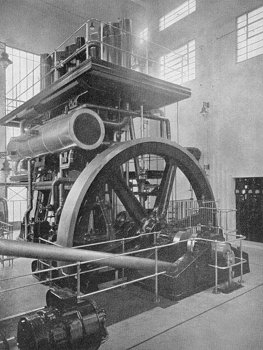
Dimmingsdale pumping engine.
|
At the time of purchase, nearly all of the water was taken from the
River Worfe at Cosford and forced by steam power to the top of
Summerhouse Hill and then by gravity along the seven miles to Tettenhall
reservoir. From here it was pumped to all parts of the town and
Goldthorn Hill reservoir through iron pipes. This water supply was of a
lower quality than desired and insufficient for the needs of the growing
population. In 1876 the Water Committee engaged Henry Marten, C.E., who
had previously worked for the old Waterworks Company, to look at the
problem.
Henry visited Cosford Waterworks and looked at the local geology. He
suggested that the Corporation should sink large artesian wells and deep
borings through the old red sandstone to where a large underground
reservoir could be tapped. An enormous quantity of water would rise to
the surface and an abundant supply of pure water could be obtained from
several such wells.
|
| The Council adopted the scheme and the Water
Committee engaged contractors to undertake the work. Two
artesian wells were constructed, each 12 feet in diameter. One
was 120 feet deep and the other was 140 feet deep. Two deep
boreholes were sunk within a few feet of the wells and connected
to them by a tunnel. One was 919 feet deep and 24 inches wide,
and the other was 534 feet deep and 15 inches wide. The
boreholes pierced through the old red sandstone and tapped the
underground reservoir. Large volumes of water flowed into the
two artesian wells and powerful engines were erected to deal
with it. |
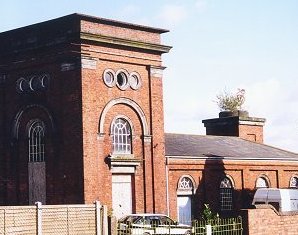
The Re-Pumping Station on Goldthorn Hill.
|
| This was a great success and a plentiful supply
of pure water was now available. By 1900 between 3 to 4 million
gallons a day were drawn from the wells.
Wolverhampton’s population continued to increase and the
amount of water from the artesian wells was slowly decreasing.
The Water Committee looked into the matter and submitted a
scheme to the Town Council. The plan was to sink deep wells near
Stableford and Hilton, in an area that was partly in
Staffordshire and partly in Shropshire. The Council adopted the
proposal and had a Bill drawn up for submission to Parliament. |
|
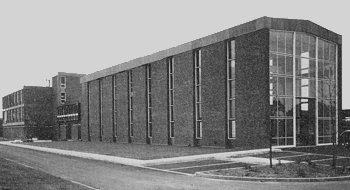
Hampton Loade Water Works.
|
The area proposed for the scheme was predominantly
agricultural and there was much opposition from farmers and
local members of Parliament. The Bill went before Parliament on
12th March, 1901 and was defeated by 85 votes. It was
said at the time that many members were voting for party
political reasons rather than the merits of the Bill. The Town
Council was very disappointed at the outcome. |
| Finding no other local district suitable for the
purpose, the Council decided to apply to Parliament again and a
second Bill was drawn up. In the second Bill clauses were added
to appease local landowners in the hope of removing any
opposition. The Corporation stated that it would supply, free of
cost, water to persons whose land was situated within two miles
of the waterworks and offered full compensation to anyone badly
affected by the scheme. The offers of compensation were clearly
inadequate, as there were if anything, more objections raised
the second time round and the Bill was again defeated. |
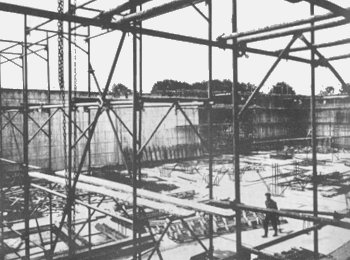
The 5,000,000 gallon covered service
reservoir on Goldthorn Hill, during construction in the early
1950s. The reservoir was constructed from reinforced concrete. |
|
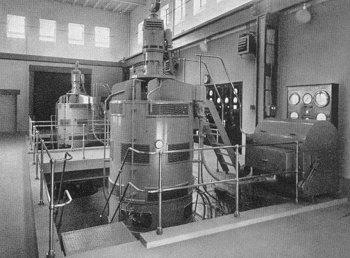
Electrical pumping plant at Hilton Water
Works.
|
In order to obtain additional supplies of water,
the Water Committee constructed large filters close to Cosford’s
River Worfe, so that water from the brook could be purified and
added to the existing supply. The river water was passed through
Jewell Rapid Filters, sterilised and mixed with the water from
the boreholes and artesian wells. A new reservoir was built at
Bushbury which had a capacity of 2,000,000 gallons and some of
the higher districts were fed with water from electrically
operated re-pumping stations at Goldthorn Hill and Short Heath,
and elevated tanks at Goldthorn Hill and Essington. |
Read a booklet produced by
the Water Committee
in 1911 |
 |
A new waterworks was also built at Dimmingsdale to supply
Wolverhampton and some of the surrounding areas.
Over the intervening years the Water Committee developed and
extended the undertaking to keep pace with the requirements of
the growing population and thriving industry. Works were finally
opened at Stableford and Hilton, along with others at Bratch,
Tomhill, Rindleford, Copley and Neachley. All of the water other
than that extracted from the River Worfe, was from deep wells
and boreholes. |
|
In the 1960s a new scheme was developed jointly with the South
Staffordshire Waterworks Company to take water from the River Severn at
Hampton Loade. The Corporation’s waterworks eventually supplied about
152 square miles in Staffordshire and Shropshire, including
Wolverhampton, Bridgnorth, Shifnal, Sieson, and parts of Walsall,
Dudley, West Bromwich and Cannock. Another re-pumping station was opened
at Sandbeds.
The Head Office of the water department was in the Town Hall with the
Distribution Department at 45 Darlington Street.
|
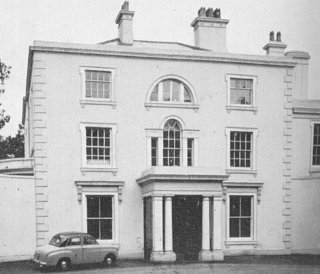
The new water offices at 'The Oaks'.
|
| In 1953 the Corporation acquired ‘The Oaks’ in
Merridale Road and converted the house into offices for the
water department. The undertaking remained under the control of
the local authority until 1989 when the industry was
privatised. |
 |
|

|
|

|
Return to
An Unfortunate Episode |
|
Return to
the beginning |
|
Proceed to
Sewage
|
|